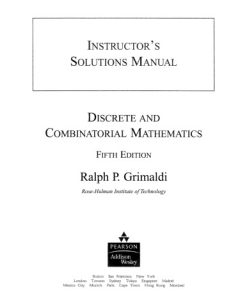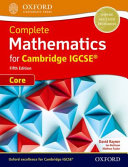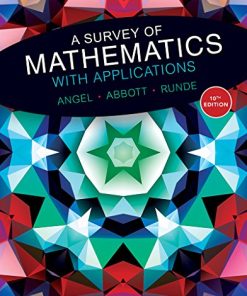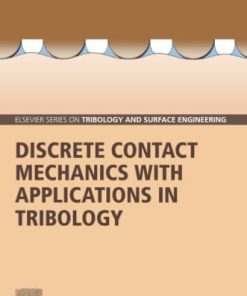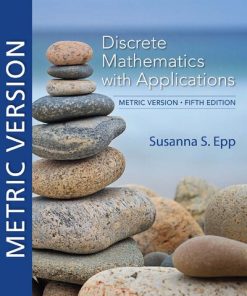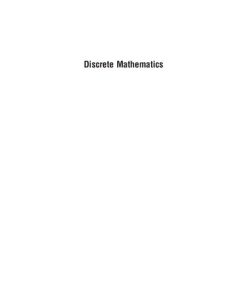(EBook PDF) Discrete Mathematics with Applications 5th Edition by Susanna Epp 9798214341712 full chapters
$50.00 Original price was: $50.00.$25.00Current price is: $25.00.
Discrete Mathematics with Applications 5th Edition by Susanna S. Epp – Ebook PDF Instant Download/DeliveryISBN: 9798214341712
Full dowload Discrete Mathematics with Applications 5th Edition after payment.
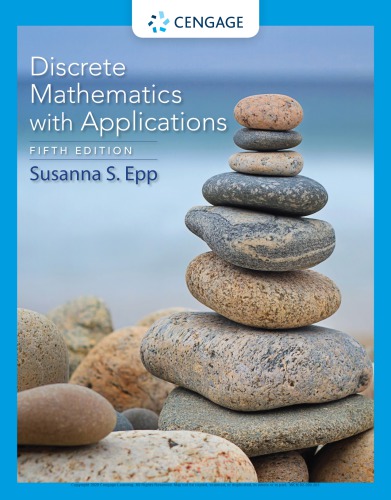
Product details:
ISBN-13 : 9798214341712
Author: Susanna S. Epp
Known for its accessible, precise approach, Epp’s DISCRETE MATHEMATICS WITH APPLICATIONS, 5th Edition, introduces discrete mathematics with clarity and precision. Coverage emphasizes the major themes of discrete mathematics as well as the reasoning that underlies mathematical thought. Students learn to think abstractly as they study the ideas of logic and proof. While learning about logic circuits and computer addition, algorithm analysis, recursive thinking, computability, automata, cryptography and combinatorics, students discover that ideas of discrete mathematics underlie and are essential to today’s science and technology. The author’s emphasis on reasoning provides a foundation for computer science and upper-level mathematics courses.
Discrete Mathematics with Applications 5th Table of contents:
Chapter 1. Speaking Mathematically
1.1. Variables
Some Important Kinds of Mathematical Statements
Universal Conditional Statements
Universal Existential Statements
Existential Universal Statements
Test Yourself
Exercise Set 1.1
1.2. The Language of Sets
Subsets
Cartesian Products
Test Yourself
Exercise Set 1.2
1.3. The Language of Relations and Functions
Arrow Diagram of a Relation
Functions
Function Machines
Test Yourself
Exercise Set 1.3
1.4. The Language of Graphs
Examples of Graphs
Test Yourself
Exercise Set 1.4
Chapter 2. The Logic of Compound Statements
2.1. Logical Form and Logical Equivalence
Statements
Compound Statements
Truth Values
Evaluating the Truth of More General Compound Statements
Logical Equivalence
Tautologies and Contradictions
Summary of Logical Equivalences
Test Yourself
Exercise Set 2.1
2.2. Conditional Statements
Logical Equivalences Involving →
Representation of If-Then as Or
The Negation of a Conditional Statement
The Contrapositive of a Conditional Statement
The Converse and Inverse of a Conditional Statement
Only If and the Biconditional
Necessary and Sufficient Conditions
Remarks
Test Yourself
Exercise Set 2.2
2.3. Valid and Invalid Arguments
Modus Ponens and Modus Tollens
Additional Valid Argument Forms: Rules of Inference
Fallacies
Contradictions and Valid Arguments
Summary of Rules of Inference
Test Yourself
Exercise Set 2.3
2.4. Application: Digital Logic Circuits
Black Boxes and Gates
The Input/Output Table for a Circuit
The Boolean Expression Corresponding to a Circuit
The Circuit Corresponding to a Boolean Expression
Finding a Circuit That Corresponds to a Given Input/Output Table
Simplifying Combinational Circuits
NAND and NOR Gates
Test Yourself
Exercise Set 2.4
2.5. Application: Number Systems and Circuits for Addition
Binary Representation of Numbers
Binary Addition and Subtraction
Circuits for Computer Addition
Two’s Complements and the Computer Representation of Signed Integers
Addition and Subtraction with Integers in Two’s Complement Form
Hexadecimal Notation
Test Yourself
Exercise Set 2.5
Chapter 3. The Logic of Quantified Statements
3.1. Predicates and Quantified Statements I
The Universal Quantifier: ∀
The Existential Quantifier: ∃
Formal vs. Informal Language
Universal Conditional Statements
Equivalent Forms of Universal and Existential Statements
Bound Variables and Scope
Implicit Quantification
Tarski’s World
Test Yourself
Exercise Set 3.1
3.2. Predicates and Quantified Statements II
Negations of Quantified Statements
Negations of Universal Conditional Statements
The Relation among ∀ , ∃ , ∧ , and ∨
Vacuous Truth of Universal Statements
Variants of Universal Conditional Statements
Necessary and Sufficient Conditions, Only If
Test Yourself
Exercise Set 3.2
3.3. Statements with Multiple Quantifiers
Translating from Informal to Formal Language
Ambiguous Language
Negations of Statements with More Than One Quantifier
Order of Quantifiers
Formal Logical Notation
Prolog
Test Yourself
Exercise Set 3.3
3.4. Arguments with Quantified Statements
Universal Modus Ponens
Use of Universal Modus Ponens in a Proof
Universal Modus Tollens
Proving Validity of Arguments with Quantified Statements
Using Diagrams to Test for Validity
Creating Additional Forms of Argument
Remark on the Converse and Inverse Errors
Test Yourself
Exercise Set 3.4
Chapter 4. Elementary Number Theory and Methods of Proof
4.1. Direct Proof and Counterexample I: Introduction
Even, Odd, Prime, and Composite Integers
Proving Existential Statements
Disproving Universal Statements by Counterexample
Proving Universal Statements
Getting Proofs Started
Test Yourself
Exercise Set 4.1
4.2. Direct Proof and Counterexample II: Writing Advice
Directions for Writing Proofs of Universal Statements
Variations among Proofs
Common Mistakes
Showing That an Existential Statement Is False
Conjecture, Proof, and Disproof
Test Yourself
Exercise Set 4.2
4.3. Direct Proof and Counterexample III: Rational Numbers
More on Generalizing from the Generic Particular
Proving Properties of Rational Numbers
Deriving New Mathematics from Old
Test Yourself
Exercise Set 4.3
4.4. Direct Proof and Counterexample IV: Divisibility
Proving Properties of Divisibility
Counterexamples and Divisibility
The Unique Factorization of Integers Theorem
Test Yourself
Exercise Set 4.4
4.5. Direct Proof and Counterexample V: Division into Cases and the Quotient-Remainder Theorem
div and mod
Representations of Integers
Absolute Value and the Triangle Inequality
Test Yourself
Exercise Set 4.5
4.6. Direct Proof and Counterexample VI: Floor and Ceiling
Test Yourself
Exercise Set 4.6
4.7. Indirect Argument: Contradiction and Contraposition
Argument by Contraposition
Relation between Proof by Contradiction and Proof by Contraposition
Proof as a Problem-Solving Tool
Test Yourself
Exercise Set 4.7
4.8. Indirect Argument: Two Famous Theorems
The Irrationality of 2
Are There Infinitely Many Prime Numbers?
When to Use Indirect Proof
Open Questions in Number Theory
Test Yourself
Exercise Set 4.8
4.9. Application: The Handshake Theorem
Special Graphs
Test Yourself
Exercise Set 4.9
4.10. Application: Algorithms
An Algorithmic Language
A Notation for Algorithms
The Division Algorithm
The Euclidean Algorithm
Test Yourself
Exercise Set 4.10
Chapter 5. Sequences, Mathematical Induction, and Recursion
5.1. Sequences
Summation Notation
Product Notation
Properties of Summations and Products
Change of Variable
Factorial and “ n Choose r ” Notation
Sequences in Computer Programming
Application: Algorithm to Convert from Base 10 to Base 2 Using Repeated Division by 2
Test Yourself
Exercise Set 5.1
5.2. Mathematical Induction I: Proving Formulas
Proving an Equality
Deducing Additional Formulas
Test Yourself
Exercise Set 5.2
5.3. Mathematical Induction II: Applications
A Problem with Trominoes
Test Yourself
Exercise Set 5.3
5.4. Strong Mathematical Induction and the Well-Ordering Principle for the Integers
Applying Strong Mathematical Induction
The Well-Ordering Principle for the Integers
Test Yourself
Exercise Set 5.4
5.5. Application: Correctness of Algorithms
Assertions
Loop Invariants
Correctness of the Division Algorithm
Correctness of the Euclidean Theorem
Test Yourself
Exercise Set 5.5
5.6. Defining Sequences Recursively
Examples of Recursively Defined Sequences
Recursive Definitions of Sum and Product
Test Yourself
Exercise Set 5.6
5.7. Solving Recurrence Relations by Iteration
The Method of Iteration
Using Formulas to Simplify Solutions Obtained by Iteration
Checking the Correctness of a Formula by Mathematical Induction
Discovering That an Explicit Formula Is Incorrect
Test Yourself
Exercise Set 5.7
5.8. Second-Order Linear Homogeneous Recurrence Relations with Constant Coefficients
The Distinct-Roots Case
The Single-Root Case
Test Yourself
Exercise Set 5.8
5.9. General Recursive Definitions and Structural Induction
Recursively Defined Sets
Proving Properties about Recursively Defined Sets
Recursive Functions
Test Yourself
Exercise Set 5.9
Chapter 6. Set Theory
6.1. Set Theory: Definitions and the Element Method of Proof
Subsets: Proof and Disproof
Set Equality
Venn Diagrams
Operations on Sets
The Empty Set
Partitions of Sets
Power Sets
An Algorithm to Check Whether One Set Is a Subset of Another (Optional)
Test Yourself
Exercise Set 6.1
6.2. Properties of Sets
Proving a Subset Relation
Set Identities
The Empty Set
Test Yourself
Exercise Set 6.2
6.3. Disproofs and Algebraic Proofs
Disproving an Alleged Set Property
Problem-Solving Strategy
The Number of Subsets of a Set
“Algebraic” Proofs of Set Identities
Test Yourself
Exercise Set 6.3
6.4. Boolean Algebras, Russell’s Paradox, and the Halting Problem
Russell’s Paradox
The Halting Problem
Test Yourself
Exercise Set 6.4
Chapter 7. Properties of Functions
7.1. Functions Defined on General Sets
Arrow Diagrams
Examples of Functions
Boolean Functions
Checking Whether a Function Is Well Defined
Functions Acting on Sets
Test Yourself
Exercise Set 7.1
7.2. One-to-One, Onto, and Inverse Functions
One-to-One Functions
One-to-One Functions on Infinite Sets
Application: Hash Functions
Onto Functions
Onto Functions on Infinite Sets
Relations between Exponential and Logarithmic Functions
One-to-One Correspondences
Inverse Functions
Test Yourself
Exercise Set 7.2
7.3. Composition of Functions
Composition of One-to-One Functions
Composition of Onto Functions
Test Yourself
Exercise Set 7.3
7.4. Cardinality with Applications to Computability
Countable Sets
The Search for Larger Infinities: The Cantor Diagonalization Process
Application: Cardinality and Computability
Test Yourself
Exercise Set 7.4
Chapter 8. Properties of Relations
8.1. Relations on Sets
The Inverse of a Relation
Directed Graph of a Relation
N-ary Relations and Relational Databases
Test Yourself
Exercise Set 8.1
8.2. Reflexivity, Symmetry, and Transitivity
Properties of Relations on Infinite Sets
The Transitive Closure of a Relation
Test Yourself
Exercise Set 8.2
8.3. Equivalence Relations
The Relation Induced by a Partition
Definition of an Equivalence Relation
Equivalence Classes of an Equivalence Relation
Congruence Modulo n
A Definition for Rational Numbers
Test Yourself
Exercise Set 8.3
8.4. Modular Arithmetic with Applications to Cryptography
Properties of Congruence Modulo n
Modular Arithmetic
Extending the Euclidean Algorithm
Finding an Inverse Modulo n
RSA Cryptography
Euclid’s Lemma
Fermat’s Little Theorem
Why Does the RSA Cipher Work?
Message Authentication
Additional Remarks on Number Theory and Cryptography
Test Yourself
Exercise Set 8.4
8.5. Partial Order Relations
Antisymmetry
Partial Order Relations
Lexicographic Order
Hasse Diagrams
Partially and Totally Ordered Sets
Topological Sorting
An Application
PERT and CPM
Test Yourself
Exercise Set 8.5
Chapter 9. Counting and Probability
9.1. Introduction to Probability
Counting the Elements of a List
Test Yourself
Exercise Set 9.1
9.2. Possibility Trees and the Multiplication Rule
The Multiplication Rule
When the Multiplication Rule Is Difficult or Impossible to Apply
Permutations
Permutations of Selected Elements
Test Yourself
Exercise Set 9.2
9.3. Counting Elements of Disjoint Sets: The Addition Rule
The Difference Rule
The Inclusion/Exclusion Rule
Test Yourself
Exercise Set 9.3
9.4. The Pigeonhole Principle
Application to Decimal Expansions of Fractions
Generalized Pigeonhole Principle
Proof of the Pigeonhole Principle
Test Yourself
Exercise Set 9.4
9.5. Counting Subsets of a Set: Combinations
Some Advice about Counting
Test Yourself
Exercise Set 9.5
9.6. r-Combinations with Repetition Allowed
Remark: Deciding Which Formula to Use
Test Yourself
Exercise Set 9.6
9.7. Pascal’s Formula and the Binomial Theorem
Pascal’s Formula
The Binomial Theorem
Test Yourself
Exercise Set 9.7
9.8. Probability Axioms and Expected Value
Expected Value
Test Yourself
Exercise Set 9.8
9.9. Conditional Probability, Bayes’ Formula, and Independent Events
Conditional Probability
Bayes’ Theorem
Independent Events
Test Yourself
Exercise Set 9.9
Chapter 10. Theory of Graphs and Trees
10.1. Trails, Paths, and Circuits
Definitions
Subgraphs
Connectedness
Euler Circuits
Hamiltonian Circuits
Test Yourself
Exercise Set 10.1
10.2. Matrix Representations of Graphs
Matrices
Matrices and Directed Graphs
Matrices and Undirected Graphs
Matrices and Connected Components
Matrix Multiplication
Counting Walks of Length N
Test Yourself
Exercise Set 10.2
10.3. Isomorphisms of Graphs
Graph Isomorphism for Simple Graphs
Test Yourself
Exercise Set 10.3
10.4. Trees: Examples and Basic Properties
Examples of Trees
Characterizing Trees
Test Yourself
Exercise Set 10.4
10.5. Rooted Trees
Binary Trees
Binary Search Trees
Test Yourself
Exercise Set 10.5
10.6. Spanning Trees and a Shortest Path Algorithm
Minimum Spanning Trees
Kruskal’s Algorithm
Prim’s Algorithm
Dijkstra’s Shortest Path Algorithm
Test Yourself
Exercise Set 10.6
Chapter 11. Analysis of Algorithm Efficiency
11.1. Real-Valued Functions of a Real Variable and Their Graphs
Power Functions
The Floor Function
Graphing Functions Defined on Sets of Integers
Graph of a Multiple of a Function
Increasing and Decreasing Functions
Test Yourself
Exercise Set 11.1
11.2. Big- O , Big-Omega, and Big-Theta Notations
Orders of Power Functions
Orders of Polynomial Functions
Test Yourself
Exercise Set 11.2
11.3. Application: Analysis of Algorithm Efficiency I
The Sequential Search Algorithm
Measuring the Efficiency of an Algorithm
The Insertion Sort Algorithm
Test Yourself
Exercise Set 11.3
11.4. Exponential and Logarithmic Functions: Graphs and Orders
Graphs of Exponential Functions
Graphs of Logarithmic Functions
Application: Number of Bits Needed to Represent an Integer in Binary Notation
Application: Using Logarithms to Solve Recurrence Relations
Exponential and Logarithmic Orders
Test Yourself
Exercise Set 11.4
11.5. Application: Analysis of Algorithm Efficiency II
Binary Search
The Efficiency of the Binary Search Algorithm
Merge Sort
Tractable and Intractable Problems
A Final Remark on Algorithm Efficiency
Test Yourself
Exercise Set 11.5
Chapter 12. Regular Expressions and Finite-State Automata
12.1. Formal Languages and Regular Expressions
The Language Defined by a Regular Expression
Practical Uses of Regular Expressions
Test Yourself
Exercise Set 12.1
12.2. Finite-State Automata
Definition of a Finite-State Automaton
The Language Accepted by an Automaton
The Eventual-State Function
Designing a Finite-State Automaton
Simulating a Finite-State Automaton Using Software
Finite-State Automata and Regular Expressions
Regular Languages
Test Yourself
Exercise Set 12.2
12.3. Simplifying Finite-State Automata
*-Equivalence of States
k -Equivalence of States
Finding the *-Equivalence Classes
The Quotient Automaton
Constructing the Quotient Automaton
Equivalent Automata
People also search for Discrete Mathematics with Applications 5th:
molecular nutrition pdf
ortho molecular nutrition
biochemical and molecular nutrition
molecular nutrition supplements
molecular nutrition x-factor
You may also like…
Mathematics - Discrete Mathematics
Discrete and Combinatorial Mathematics ,5th (Instructor’s Solution Manual) Ralph P. Grimaldi
Education Studies & Teaching - School Education & Teaching
Computers - Computer Science
Technique - Construction
Discrete Contact Mechanics with Applications in Tribology 1st Edition Irina Goryacheva
Mathematics - Discrete Mathematics
Discrete Mathematics with Applications: Metric Version 5th Edition
Mathematics



